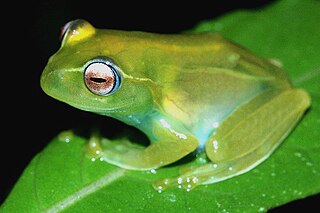
Cophylinae is a subfamily of microhylid frogs endemic to Madagascar. It has over 100 species in eight genera. Members of this subfamily range from minute to fairly large, and they are highly ecologically diverse. DNA barcode research has revealed a significant taxonomic gap in this subfamily, and an estimated 70+ candidate species were identified. Many of these have subsequently been described, as well as numerous new discoveries.

Stumpffia is a genus of microhylid frogs that are endemic to Madagascar. They are mostly brown frogs that typically live among leaf litter. S. contumelia has a snout–vent length of about 8–9 mm (0.31–0.35 in), making it one of the world's smallest frogs, and several others in the genus are only slightly larger. The largest species is no more than 28 mm (1.1 in).

Mantellinae is a subfamily of frogs in the family Mantellidae. These frogs are native to Madagascar and Mayotte. The species vary in size from under 25 mm to over 100 mm. The subfamily is most famous for the genus Mantella, which contains species that superficially resemble poison dart frogs of the tropical Americas, and have converged on similar aposematic colouration and toxins. As of 2 May 2016, there are 128 described species in this subfamily, but several more are described each year.

Mantidactylus is a frog genus in the mantellid subfamily Mantellinae. This genus is restricted to Madagascar. The genus is divided into several subgenera that form monophyletic genetic clusters and are ecologically similar.

Aglyptodactylus is a genus of frogs in the family Mantellidae. These frogs, sometimes known as the Madagascar jumping frogs, are endemic to Madagascar. Systematic revisions of the groups were published in 1998 and 2015. Six species are currently recognized.

Boophis is the only genus in the mantellid frog subfamily Boophinae. They are commonly known as bright-eyed or skeleton frogs. They show typical 'tree frog' traits, and are a good example of convergent evolution with morphologically similar species in the families Hylidae and Rhacophoridae, among others. This genus can only be found on Madagascar and Mayotte Island (Comoros).
Boophis feonnyala is a species of frogs in the family Mantellidae.

Boophis occidentalis is a species of frog in the family Mantellidae. It is endemic to Madagascar. Its natural habitats are subtropical or tropical dry forests, rivers, pastureland, urban areas, and heavily degraded former forest. It is threatened by habitat loss.
Wakea madinika is a species of frogs in the mantellid subfamily Mantellinae. It is the only species in the monotypic genus Wakea. It is endemic to Madagascar.

Boehmantis is a genus of frogs in the mantellid subfamily Mantellinae. It is monotypic, being represented by a single species, Boehmantis microtympanum. The genus is endemic to Madagascar.

Rhombophryne is a genus of microhylid frogs endemic to Madagascar. It is currently estimated to include more than 23 species, but only 20 of these are currently described. The common name 'diamond frog' has been proposed and used for members of this genus.

Gephyromantis is a frog genus in the mantellid subfamily Mantellinae. This genus is restricted to Madagascar. At present it contains 45 species divided into six subgenera.

Spinomantis is a frog genus in the mantellid subfamily Mantellinae. This genus is restricted to Madagascar. At present it contains 13 species. They are arboreal or terrestrial frogs and occur in or along small streams. Most species are nocturnal.

Guibemantis is a frog genus in the mantellid subfamily Mantellinae. This genus is restricted to Madagascar. At present it contains 16 species divided into two subgenera.

Rhombophryne serratopalpebrosa is a species of frog of the Madagascar endemic microhylid subfamily Cophylinae. Genetic evidence revealed that it is a species complex, in need of resolution. This work has made significant progress, and five related species have been described from this complex between 2014 and 2017. It is threatened by habitat loss.

Spinomantis massi is a species of frog in the mantellid subfamily Mantellinae. It is endemic to the humid forests of northwestern Madagascar.
Spinomantis microtis is a species of frog in the Mantellid subfamily Mantellinae, endemic to Madagascar.

Andolalao Rakotoarison is a Malagasy herpetologist.

The femoral gland is a specialised gland found in some male frogs that plays a role in chemical communication and reproductive signalling. Particularly prominent within the frog family Mantellidae, these glands are located on the underside of the hindlimbs, usually on the inner thighs or shanks. Femoral glands can be identified by their swollen appearance and distinct colouration, which differ from the surrounding skin. Femoral glands are classified into four distinct morphological types, varying from minute granular structures to conspicuous patches characterised by large granules and prominent central indentations.

















